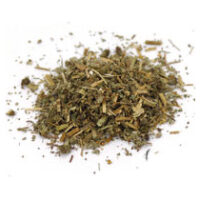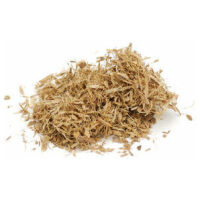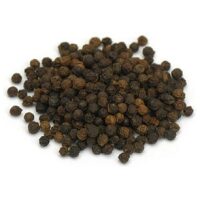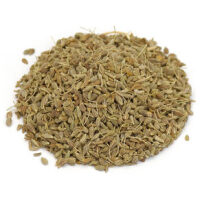Western Bulk Herbs – Solomon’s Seal
Western Bulk Herbs Solomon’s Seal
A close relative to the Lily-of-the-Valley, and was formerly assigned to the same genus, Convallaria. It is a popular plant in gardens and plantations; a native of Northern Europe and Siberia, extending to Switzerland and Carniola. In England it is found, though rarely, growing wild in woods in York, Kent and Devon, but where found in Scotland and Ireland is regarded as naturalized. The Dwarf Solomon’s Seal is found in the woods of Wiltshire.
—Description—The creeping root-stock, or underground stem, is thick and white, twisted and full of knots, with circular scars at intervals, left by the leaf stems of previous years. It throws up stems that attain a height of from 18 inches to 2 feet, or even more, which are for some considerable portion of their length erect, but finally bend gracefully over. They are round, pale-green in colour, and bare half-way up; from thence to the top, large and broadly-oval leaves grow alternately on the stem, practically clasping it by the bases. All the leaves have the character of turning one way, being bent slightly upward, as well as to one side, and have very marked longitudinal ribbing on their surfaces.
The flowers are in little drooping clusters of from two to seven, springing from the axils of the leaves, but hanging in an opposite direction to the foliage. They are tubular in shape, of a creamy or waxy white, topped with a yellowish-green, and sweet-scented, and are succeeded by small berries about the size of a pea, of a blackish-blue colour, varying to purple and red, and containing about three or four seeds.
The generic name Polygonatum signifies many-angled, and is supposed to be derived either from the numerous knots or swellings of the root or from the numerous nodes or joints of the stem, but the characteristics are not very marked ones. The specific name, multiflorum, serves to distinguish this manyflowered species from another in which the blossoms are solitary, or only in pairs from each axil.
The origin of the common English name of the plant is variously given. Dr. Prior tells us it comes from ‘the flat, round scars on the rootstocks, resembling the impressions of a seal and called Solomon’s, because his seal occurs in Oriental tales.’
Another explanation is that these round depressions, or the characters which appear when the root is cut transversely, and which somewhat resemble Hebrew characters, gave rise to the notion that Solomon ‘who knew the diversities of plants and the virtues of roots,’ has set his seal upon them in testimony of its value to man as a medicinal root.
Gerard maintained that the name Sigillum Solomons was given to the root partly because it bears marks something like the stamp of a seal, but still more because of the virtue the root hath in sealing and healing up green wounds, broken bones and such like, being stamp’t and laid thereon.’
The name Lady’s Seal was also conferred on the plant by old writers, as also St. Mary’s Seal (Sigillum Sanctae Mariae).
[Top]
—Cultivation—Solomon’s Seal is a very hardy plant. It prefers a light soil and a shady situation, being a native of woods. If in a suitable soil and situation and not crowded by shrubs, it will thrive and multiply very rapidly by the creeping rootstocks. It will be better for occasional liberal dressings of leafmould, or an annual top dressing of decayed manure in March.
Seeds, sown as soon as gathered in the autumn, germinate in early spring, or the roots may be divided to any extent. The best time to transplant or part the roots is in autumn, after the stalks decay, but it may safely be done at any time, if taken up with plenty of soil, until they begin to shoot in the spring, when the ground should be dug about them and kept clean from weeds. They should also have room to spread and must not be removed oftener than every third or fourth year.
To give Solomon’s Seal a good start when planting, the soil should be well broken up with a fork and have a little mild manure worked in.
—Part Used—The root dug in autumn and dried.
—Constituents—The rhizome and herb contain Convallarin, one of the active constituents of Lily-of-the-Valley, also Asparagin, gum, sugar, starch and pectin.
[Top]
—Medicinal Action and Uses—Astringent, demulcent and tonic. Combined with otherremedies, Solomon’s Seal is given in pulmonary consumption and bleeding of the lungs. It is useful also in female complaints. The infusion of 1 OZ. to a pint of boiling water is taken in wineglassful doses and is also used as an injection. It is a mucilaginous tonic, very healing and restorative, and is good in inflammations of the stomach and bowels, piles, and chronic dysentery.
A strong decoction given every two or three hours has been found to cure erysipelas, if at the same time applied externally to the affected parts.
The powdered roots make an excellent poultice for bruises, piles, inflammations and tumours. The bruised roots were much used as a popular cure for black eyes, mixed with cream. The bruised leaves made into a stiff ointment with lard served the same purpose. Gerard says:
‘The roots of Solomon’s Seal, stamped while it is fresh and greene and applied, taketh away in one night or two at the most, any bruise, blacke or blew spots gotten by fals or women’s wilfulness in stumbling upin their hastie husband’s fists, or such like.’
A decoction of the root in wine was considered a suitable beverage for persons with broken bones, ‘as it disposes the bones to knit.’ On this point, Gerard adds:
‘As touching the knitting of bones and that truly which might be written, there is not another herb to be found comparable to it for the purposes aforesaid; and therefore in briefe, if it be for bruises inward, the roots must be stamped, some ale or wine put thereto and strained and given to drinke . . . as well unto themselves as to their cattle,’ it being applied ‘outwardly in the manner of a pultis’ for external bruises.
Parkinson says, ‘The Italian dames, however, doe much use the distilled water of the whole plant of Solomon’s Seal’ – for their complexions, etc.
In Galen’s time, the distilled water was used as a cosmetic, and Culpepper says:
‘the diluted water of the whole plant used to the face or other parts of the skin, cleanses it from freckles, spots or any marks whatever, leaving the place fresh, fair and lovely, for which purpose it is much used by the Italian ladies and is the principal ingredient of most of the cosmetics and beauty washes advertised by perfumers at high price.’
The roots macerated for some time in water yield a substance capable of being used as food and consisting principally of starch. The young shoots form an excellent vegetable when boiled and eaten like Asparagus, and are largely consumed in Turkey. The roots of another species have been made into bread in times of scarcity, but they require boiling or baking before use.
The flowers and roots used as snuff are celebrated for their power of inducing sneezing and thereby relieving head affections. They also had a wide vogue as aphrodisiacs, for love philtres and potions.
The berries are stated to excite vomiting, and even the leaves, nausea, if chewed.
The properties of these roots have not been very fully investigated. It is stated that a decoction will afford not only relief but ultimate cure in skin troubles caused by the poison vine, or poisonous exalations of other plants.
Dosage of the decoction: 1 to 4 OZ. three times daily.
As a remedy for piles the following has been found useful: 4 OZ. Solomon’s Seal, 2 pints water, 1 pint molasses. Simmer down to 1 pint, strain, evaporate to the consistence of a thick fluid extract, and mix with it from 1/2 to 1 OZ. of powdered resin. Dosage: 1 teaspoonful several times daily.
Latin Name:
Polygonatum biflorum
Common Name:
Parts Used:
Properties:
Traditional Uses:
Internal Applications:
Topical Uses / Applications:
Culinary Uses:
Chemical Properties:
Folk Lore:
Cautions:
*Disclaimer: These statements have not been evaluated by the Food and Drug Administration. This product is not intended to diagnose, treat, cure or prevent any disease.
Resources:







Reviews
There are no reviews yet.